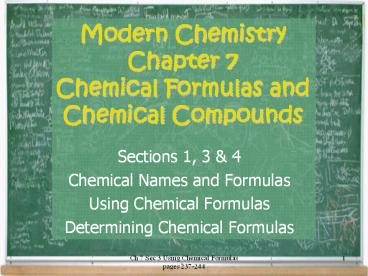Modern Chemistry Chapter 7 Chemical Formulas and Chemical Compounds - PowerPoint PPT Presentation
1 / 27
Title:
Modern Chemistry Chapter 7 Chemical Formulas and Chemical Compounds
Description:
Modern Chemistry Chapter 7 Chemical Formulas and Chemical Compounds Sections 1, 3 & 4 Chemical Names and Formulas Using Chemical Formulas Determining Chemical Formulas – PowerPoint PPT presentation
Number of Views:950
Avg rating:3.0/5.0
Title: Modern Chemistry Chapter 7 Chemical Formulas and Chemical Compounds
1
Modern ChemistryChapter 7Chemical Formulas and
Chemical Compounds
- Sections 1, 3 4
- Chemical Names and Formulas
- Using Chemical Formulas
- Determining Chemical Formulas
2
Chapter Vocabulary
- Monatomic ion
- Binary compound
- Nomenclature
- Oxyanion
- Salt
- Formula Mass
- Percent Composition
- Empirical Formula
3
Section 3
- Using Chemical Formulas
4
Definitions
- Formula Mass
- the mass of any molecule, formula unit or ion.
- The sum of all the average atomic masses of all
the atoms represented by the formula - Unit a.m.u.
- Molecular mass
- Mass of a molecule in a.m.u.
5
Definitions
- Molar mass
- the mass of one mole of atoms of an element
- The mass of one mole of molecules or formula
units of a compound - Numerically equal to formula mass
- Unit grams/mole (g/mol)
6
Calculating Formula Mass or Molar Mass
- List the elements in the compound.
- List the number of atoms of each element.
- Multiply each number of atoms by the
- Relative atomic mass (for formula mass)
- Molar mass (for molar mass)
- Add the products.
7
Calculating Formula Mass or Molar Mass
(NH4)2SO4
N H S O
2 8 1 4
x 14.01 28.02 x 1.008 8.064 x 32.06 32.06
x 16.00 64.00
- Multiply each number of atoms by the
- Relative atomic mass (for formula mass)
- Molar mass (for molar mass)
132.144
- List the elements in the compound.
- List the number of atoms of each element.
Add the products
8
Calculating Formula Mass or Molar Mass
(NH4)2SO4
The unit is amu for formula mass. The unit is
g/mol for molar mass
9
Practice Page 238
- 1. Find the formula mass of each of the
following - a. H2SO4
- b. Ca(NO3)2
- c. PO4 3-
- d. MgCl2
10
Practice Page 239
- 2. Find the formula mass of each of the
following - a. Al2S3
- b. NaNO3
- c. Ba(OH)2
11
One mole of
Nitrogen (balloon) CdS (yellow) Water
(cylinder) NaCl (white)
- p. 239
12
Chemical Formulas Moles
H
O
2
- The formula could stand for 1 molecule of water
with 2 hydrogen atoms and 1 oxygen atom or - The formula could stand for 1 mole of water
molecule which contain 2 moles of hydrogen atoms
and 1 mole of oxygen atoms.
13
Conversions with Compounds
?
?
AMOUNTmoles
MOLAR MASS
6.022 x 10 23
x
x
PARTICLESmolecules
MASSgrams
14
Conversions with Compounds
?
?
AMOUNTmoles
MOLAR MASS
6.022 x 10 23
x
x
PARTICLESatoms
MASSgrams
15
Grams-Moles-Molecules Conversions
- p. 240
16
Dimensional Analysis
unit given
unit given
unit wanted
x
unit given
Fill in units first then numbers !
17
Dimensional Analysis
x
x
x
x
Arrange the units so that all cancel out except
the last one, which should be the one you want.
18
Practice Page 239
- 1. How many moles of atoms of each element are
there in one mole of the following compounds? - a. Al2S3
- b. NaNO3
- c. Ba(OH)2
- 2. Find the molar mass of each of the compounds
listed in item 1.
19
Practice Page 242
- 1. How many moles of compound are there in the
following? - a. 6.60 g (NH4)2SO4
- b. 4.5 kg Ca(OH)2
- 2. How many molecules are there in the following?
- a. 25.0 g H2SO4
- b. 125 g of sugar, C12H22O11
- 3. What is the mass in grams of 6.25 mol of
copper(II) nitrate?
20
Percent Composition
(NH4)2SO4
N H S O
2 8 1 4
x 14.01 28.02 x 1.008 8.064 x 32.06 32.06
x 16.00 64.00
? 132.14 .2120 ? 132.14 .06103 ? 132.14
.2426 ? 132.14 .4843
132.144
- Find the molar mass of the compound.
Divide the subtotal for each element by the molar
mass
21
Percent Composition
(NH4)2SO4
N H S O
28.02 8.064 32.06 64.00
? 132.14 .2120 ? 132.14 .06103 ? 132.14
.2426 ? 132.14 .4843
x100 21.20 x100 6.103 x100 24.26 x100
48.43
132.144
- Multiply each by 100 to get a percent.
22
Hydrates
- Salt which have the ability to bind water
molecules within their crystal lattice. - Anhydrous - salts without water
- Examples
- CuSO4 5H2O
- copper(II) sulfate pentahydrate
- CoCl2 6H2O
- cobalt (II) chloride hexahydrate
23
Hydrates
- CuSO4 ? 5H2O
CoCl2 ? 6H2O
24
What percentage of sodium carbonate decahydrate,
Na2CO3 ?10H2O, is sodium carbonate?
1. Find the molar mass of Na2CO3 (the anhydrous
compound). 2. Find the mass Na2CO3 ?10H2O (the
hydrate). 3. Divide mass of compound (anhydrous)
by mass of the hydrate and multiply by 100.
25
Percent Composition of a Hydrate
CuSO4 ? 5H2O
Cu S O H O
1 1 4 10 5
x 63.55 63.55 x 32.06 32.06 x 16.00 64.00
x 1.008 10.08 x 16.00 80.00
159.61
x 100 63.92
249.69
90.08
x 100 36.08
249.69
249.69
26
What is the percentage of MnCl2 in MnCl2 2H2O?
77.73
How much water could 100g of anhydrous MnCl2
absorb if the hydrated form is MnCl2 2H2O?
28.64g
27
Practice Page 244
- 1. Find the percentage compositions of the
following - a. PbCl2 b. Ba(NO3)2
- 2. Find the mass percentage of water in
ZnSO47H2O. - 3. Magnesium hydroxide is 54.87 oxygen by mass.
How many grams of oxygen are in 175 g of the
compound? How many moles of oxygen is this?
28
Section 3 Homework































